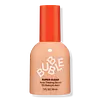What's inside
What's inside
 Key Ingredients
Key Ingredients

 Benefits
Benefits

 Concerns
Concerns

 Ingredients Side-by-side
Ingredients Side-by-side

Salicylic Acid 2%
MaskingWater
Skin ConditioningCaprylic/Capric Triglyceride
MaskingGlycerin
HumectantSodium Polyacrylate
AbsorbentHydroxyethyl Acrylate/Sodium Acryloyldimethyl Taurate Copolymer
Emulsion StabilisingNiacinamide
SmoothingPhenoxyethanol
PreservativeXanthan Gum
EmulsifyingPolyacrylate Crosspolymer-6
Emulsion StabilisingAllantoin
Skin ConditioningEthylhexylglycerin
Skin ConditioningZinc PCA
HumectantSorbitan Isostearate
EmulsifyingT-Butyl Alcohol
PerfumingSalicylic Acid 2%, Water, Caprylic/Capric Triglyceride, Glycerin, Sodium Polyacrylate, Hydroxyethyl Acrylate/Sodium Acryloyldimethyl Taurate Copolymer, Niacinamide, Phenoxyethanol, Xanthan Gum, Polyacrylate Crosspolymer-6, Allantoin, Ethylhexylglycerin, Zinc PCA, Sorbitan Isostearate, T-Butyl Alcohol
Salicylic Acid 2%
MaskingWater
Skin ConditioningGlycerin
HumectantSqualane
EmollientOctyldodecyl Stearoyl Stearate
EmollientSodium Polyacryloyldimethyl Taurate
Emulsion StabilisingSodium Polyacrylate
AbsorbentCetearyl Alcohol
EmollientCentella Asiatica Leaf Extract
Skin ConditioningColloidal Oatmeal
AbsorbentSalvia Officinalis Leaf Extract
CleansingZinc PCA
HumectantDipotassium Glycyrrhizate
HumectantMelia Azadirachta Seed Oil
EmollientSpiraea Ulmaria Flower Extract
Skin ConditioningSalix Nigra Bark Extract
Skin ProtectingXanthan Gum
EmulsifyingCoco-Glucoside
CleansingTocopheryl Acetate
AntioxidantPotassium Hydroxide
BufferingCitric Acid
BufferingPhenoxyethanol
PreservativeSalicylic Acid 2%, Water, Glycerin, Squalane, Octyldodecyl Stearoyl Stearate, Sodium Polyacryloyldimethyl Taurate, Sodium Polyacrylate, Cetearyl Alcohol, Centella Asiatica Leaf Extract, Colloidal Oatmeal, Salvia Officinalis Leaf Extract, Zinc PCA, Dipotassium Glycyrrhizate, Melia Azadirachta Seed Oil, Spiraea Ulmaria Flower Extract, Salix Nigra Bark Extract, Xanthan Gum, Coco-Glucoside, Tocopheryl Acetate, Potassium Hydroxide, Citric Acid, Phenoxyethanol
 Reviews
Reviews

Ingredients Explained
These ingredients are found in both products.
Ingredients higher up in an ingredient list are typically present in a larger amount.
Glycerin is already naturally found in your skin. It helps moisturize and protect your skin.
A study from 2016 found glycerin to be more effective as a humectant than AHAs and hyaluronic acid.
As a humectant, it helps the skin stay hydrated by pulling moisture to your skin. The low molecular weight of glycerin allows it to pull moisture into the deeper layers of your skin.
Hydrated skin improves your skin barrier; Your skin barrier helps protect against irritants and bacteria.
Glycerin has also been found to have antimicrobial and antiviral properties. Due to these properties, glycerin is often used in wound and burn treatments.
In cosmetics, glycerin is usually derived from plants such as soybean or palm. However, it can also be sourced from animals, such as tallow or animal fat.
This ingredient is organic, colorless, odorless, and non-toxic.
Glycerin is the name for this ingredient in American English. British English uses Glycerol/Glycerine.
Learn more about GlycerinPhenoxyethanol is a preservative that has germicide, antimicrobial, and aromatic properties. Studies show that phenoxyethanol can prevent microbial growth. By itself, it has a scent that is similar to that of a rose.
It's often used in formulations along with Caprylyl Glycol to preserve the shelf life of products.
Salicylic Acid (also known as beta hydroxy acid or BHA) is a well-known ingredient for treating skin that struggles with acne and clogged pores. It exfoliates both the skin's surface and deep within the pores to help clear out buildup, control oil, and reduce inflammation.
Unlike AHAs (alpha hydroxy acids), salicylic acid is oil-soluble. This allows it to penetrate into pores which makes it especially effective for treating blackheads and preventing future breakouts.
Salicylic acid is also known for its soothing properties. It has a similar structure to aspirin and can calm inflamed or irritated skin, making it a good option for acne-prone skin that is also sensitive.
Concentrations of 0.5-2% are recognized by the U.S. FDA as an over-the-counter topical acne product.
It can cause irritation and/or dryness if one's skin already has a compromised moisture barrier, so it's best to focus on repairing that before introducing this ingredient into your routine.
While salicylic acid does not increase sun sensitivity, it’s still important to wear sunscreen daily to protect your skin.
If you are looking for the ingredient called BHA or Butylated Hydroxyanisole, click here.
Learn more about Salicylic AcidSodium Polyacrylate is the sodium salt of polyacrylic acid. It is used as an absorber, emollient, and stabilizer.
This ingredient is a super-absorbent polymer - meaning it can absorb 100 to 1000 times its mass in water. As an emollient, Sodium Polyacrylate helps soften and soothe skin. Emollients work by creating a barrier to trap moisture in. This helps keep your skin hydrated.
Water. It's the most common cosmetic ingredient of all. You'll usually see it at the top of ingredient lists, meaning that it makes up the largest part of the product.
So why is it so popular? Water most often acts as a solvent - this means that it helps dissolve other ingredients into the formulation.
You'll also recognize water as that liquid we all need to stay alive. If you see this, drink a glass of water. Stay hydrated!
Learn more about WaterXanthan gum is used as a stabilizer and thickener within cosmetic products. It helps give products a sticky, thick feeling - preventing them from being too runny.
On the technical side of things, xanthan gum is a polysaccharide - a combination consisting of multiple sugar molecules bonded together.
Xanthan gum is a pretty common and great ingredient. It is a natural, non-toxic, non-irritating ingredient that is also commonly used in food products.
Learn more about Xanthan GumZinc PCA (or "zinc salt") differs slightly from zinc itself. PCA stands for pyrrolidone carboxylic acid. However, Zinc PCA comes from zinc.
It can help reduce redness, regulate sebum, and promote the general healing process of the skin.
Zinc PCA tends to be especially useful for those with oily, acne-prone skin. It's certainly an ingredient worth trying out!
Learn more about Zinc PCA